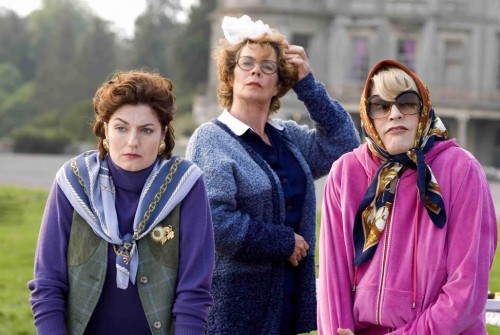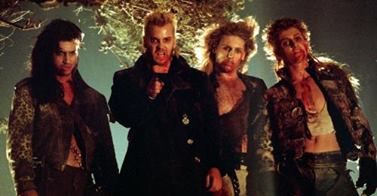This guest post written by Bethany Ainsworth-Coles is an edited version of a post that originally appeared at Tonight We Are Dinosaurs. It is cross-posted with permission.
What links the following films?
City of God, Turbo Kid, Slumdog Millionaire, The Act of Killing and Moomins on the Riviera. Got it? They all have women directors in their directorial teams. This leads to some big questions. Why didn’t we know these female directors were on the team? Why did many of us think the movies were directed by men? If they received awards recognition, why were the men the only ones awarded? Can these films be considered for the #52FilmsByWomen challenge? What happened to these women directors and why were they forgotten?
To answer these questions I needed to write more questions.
Of our original list of films, we need to split them into two sections.
Team 1:
- Slumdog Millionaire directed by Danny Boyle and co-directed by Loveleen Tandan
- The Act of Killing directed by Joshua Oppenheimer, co-directed by Christine Cynn, and co-directed by Anonymous
- City of God directed by Fernando Meirelles and co-directed by Kátia Lund
- Moomins in the Riviera directed by Xavier Picard and co-directed by Hanna Hemillä.
But then we are left with just Turbo Kid and I wanted the categories to be even. So let’s add a few more titles to Team 2.
Team 2:
- Turbo Kid directed by RKSS (François Simard, Anouk Whisell, and Yoann-Karl Whisell). RKSS is the super funky cool name of radical directorial cool cats Road Kill Super Stars.
- Little Miss Sunshine directed by Jonathan Dayton and Valerie Faris
- Ruby Sparks directed by Jonathan Dayton and Valerie Faris
- Nim’s Island directed by Jennifer Flackett and Mark Levin
Now with this in place we can start working this out.
So what’s the difference between the films in Team 1 and Team 2?
Co-Directors vs Teams.
Team 1 you may notice uses co-directors instead of directorial teams. Often this is due to eligibility in festivals, competitions, and associations. The Directors Guild of America (DGA) will not allow more than one director to direct a film as they have a one director per film policy. However, there are some notable exceptions for a “bona fide team,” including the Coen’s, Wachowski’s, and Valerie Faris & Jonathan Dayton, who we will get to later. The DGA also makes exceptions for “multi-storied” films and multilingual films. This DGA’s policy led to Robert Rodriguez dropping out of the DGA to make Sin City as they would not make an exception and allow co-directing credits for Frank Miller due to lack of experience.
Notably, the DGA does not recognize co-directors. At all. Sometimes filmmakers get around this by putting the co-director somewhere else in the credits as well and giving them another title, such as a producer. As mentioned earlier, the rule is sometimes let through for teams but not very often.
The Academy Awards also do not recognize co-directors with regards to award nominations.
What does that mean for the co-directors?
Mostly this means that people don’t know about them. Although sometimes, certain awards and competitions do give them recognition, such as the AFI Audience Award and Washington DC Area Film Critics Association who gave recognition to both Fernando Meirelles and Kátia Lund for City of God. Sadly, these awards and competitions that recognize co-directors are few and far between. Meirelles went on to make The Constant Gardner and Blindness. Lund directed some TV, including the series (fdp) and City of Men (where she once again collaborated with Meirelles). She is only just back to filmmaking; this time with new documentary Miratus.
Okay, so you’ve talked about Lund. Where are the other women co-directors now? Do they have other movies that I can support?
Loveleen Tandan, the co-director of Slumdog Millionaire, was awarded alongside Danny Boyle with the New York Film Critics Online Award for Best Director. Currently on her IMDB page, there are no new credits since Slumdog Millionaire other than a Thanks in short film The Road Home from 2010.
The Act of Killing co-director Christine Cynn collaborated again with Joshua Oppenheimer on The Look of Silence, this time as an additional Camera and she was credited with a Very Special Thanks. Cynn recently directed and co-produced the upcoming documentary Shooting Ourselves.
Hanna Hemillä was credited not just as co-director (and sometimes director) but as a writer and producer of Moomins on the Riviera. She has quite the catalog of work, especially as a producer, and undoubtedly she will continue to make more films.
So can we count Team 1 and Team 2 movies for the #52FilmsByWomen challenge?
I’d argue yes. These films are directed by a woman. There may be a man on the directorial team but I don’t think that should take away from the women directors’ work. I think it’s very important to give them recognition for the work they did, especially as many organizations won’t. So tell people, write about them. Don’t forget the female co-directors and teams and find others that have been forgotten and if you like the movie sing their praises and follow their career!
Recommended reading:
Why Not Quit the Director’s Guild? by Daniel Engber at Slate
What the Hell is a Co-Director Anyway? by Melissa Silverstein at The Huffington Post
And the Winner Isn’t… by Alex Bellos at The Guardian
DGA page 14 Section 1-301. Definition of Employees Recognised
*Thank you to Disqus user Dodo for the inspiration behind this post.
Bethany Ainsworth-Coles is a writer from England who enjoys overanalyzing things and watching movies. She can be found over at her blog Tonight We Are Dinosaurs or on Twitter @wierdbuthatsok.












